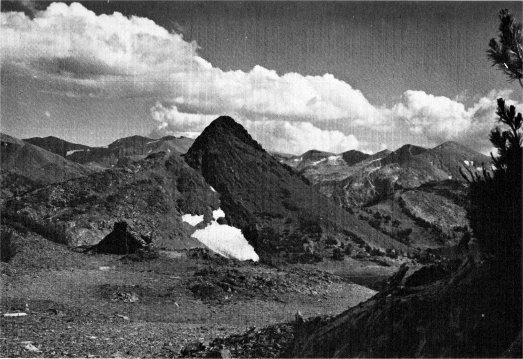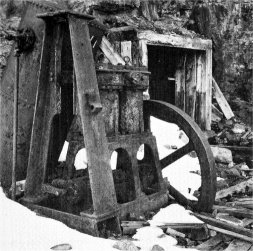
[click to enlarge]
Great Sierra Mine Cabin, Tioga Hill
| Online Library: | Title | Author | California | Geology | History | Indians | Muir | Mountaineering | Nature | Management |
Yosemite > Library > Tioga Road > The Mines >
Next: Great Sierra Wagon Road • Contents • Previous: Before the Road
Although Lt. Moore’s discoveries excited the Mariposa miners, nothing in the way of true mines seemed to come from the reports. Early in 1860 a prospecting party consisting of a justice of the peace, an ex-sea captain, a surveyor, a dentist and a professor was prospecting in the Bloody Canyon area. The dentist, George W. “Doc” Chase, remarked, while camped near Tioga Pass, that if they could but spend one more day in the area he could locate and claim “the biggest silver ledge ever discovered.” The next day he placed a flattened tin can, on which he scratched the location notice with his knife, on Tioga Hill. The ore he carried out was never assayed as he and his partners arrived at Monoville just when the Aurora

[click to enlarge] Great Sierra Mine Cabin, Tioga Hill |
Some 15 years later, William Brusky, Jr., while herding his father’s sheep, found a rusty pick and shovel and a flattened tin can, on which he could make out, “Notice, we the undersigned” and the date 1860. Having heard of the lost mine, Brusky took ore samples to his father, who tested them and pronounced them worthless. Young Brusky did not discourage easily. The next summer he “sank a small hole in the ledge and procured some better looking ore.” It was not until 1877 that an assay found the ore to be rich in silver.
Claims were not actually made until 1878 when nine were established and the Tioga Mining District organized. (15) The “city” of Dana, site of the Great Sierra Mine, was given a post office in 1880. (16) In 1881 the Great Sierra Consolidated Silver Company, financed with eastern capital, bought up all claims on Tioga Hill and started drilling a tunnel destined to go 1784 feet into the mountain, but never to produce pay dirt. (15)
On February 25, 1882 the Great Sierra Tunnel was begun by twelve miners working three 8-hour shifts. Soon it was evident that drilling machinery would be needed. (17) This was purchased and shipped to Lundy, on the east side of the Sierra. The Homer Mining Index reported: “The transportation of 16,000 lbs. of machinery across one of the highest and most rugged branches of the Sierra Nevada mountains in mid-winter where no roads exist, over vast fields and huge embankments of yielding snow and in the face of furious windstorms laden with drifting snow, and the mercury dancing attendance on zero, is a task calculated to appall the sturdiest mountaineer; yet J. C. Kemp, manager of the Great Sierra Consolidated Silver Co. is now engaged in such an undertaking, and with every prospect of success at an early day—so complete has been the arrangement of details and so intelligently directed is every movement. The first ascent, from Mill Creek to the mouth of Lake Canyon, is 990 feet, almost perpendicular. From that

[click to enlarge] Machinery hauled over the snow in 1882; Great Sierra Tunnel at right. |
“The machinery consists of an engine, boiler, air compressor, Ingersoll drills, iron pipe, etc. for use in driving the Great Sierra tunnel. It is being transported on six heavy sleds admirably constructed of hardwood. Another, or rather a pair of bobsleds accompanies the expedition, the latter being laden with bedding, provisions, cooking utensils, etc. The heaviest load is 4,200 lbs. Ten or 12 men, two mules, 4500 feet of one-inch manila rope, heavy double block and tackle and all the available trees along the route are employed in snaking the machinery up the mountain. The whole being under the immediate supervision of Mr. Kemp, who remains at the front and personally directs every movement. It is expected that all sleds will he got up into Lake Canyon today, and then the work will be pushed day and night, with two shifts of men.”
It took Kemp and his men more than two months, from March 4 until May 6, to move the eight tons a distance of about nine miles. It is said that Kemp’s remark at the end of the back-breaking task was, “It’s no wonder that men grow old!” (15)
The machinery was installed and put to work immediately upon its arrival at the mine. Meanwhile, on March 13, 1882, a post office had been established at Bennettville, company headquarters. (16) Miners swarmed to the area. More than 350 claims were located in the Tioga District alone. Bennettville was touted as an excellent location with ample room for 50,000 inhabitants, an abundant water supply and invigorating climate. (17)
Other claims were found. The May Lundy about 10 miles north of Tioga produced $3 million, though the Golden Crown, Mt. Hoffman and Mt. Gibbs groups followed the Great Sierra exam: pie. (15a) In 1881 the Sierra Telegraph Co. built a line from Lundy to Yosemite Valley via Bennettville. (15)
On July 3, 1884 the boom was over. A financial “crisis” occasioned the Great Sierra’s Executive Committee to suspend all operations and soon Dana City and Bennettville joined the silent ranks of fabled western ghost towns. Although more than $300,000 had been spent, as best we know no ore ever left the Sheepherder mine for milling. (15)* But a road had been built.
(*For the complete story of the mines see Douglass H. Hubbard’s Ghost Mines of Yosemite.)
Next: Great Sierra Wagon Road • Contents • Previous: Before the Road
| Online Library: | Title | Author | California | Geology | History | Indians | Muir | Mountaineering | Nature | Management |
http://www.yosemite.ca.us/library/tioga_road/mines.html